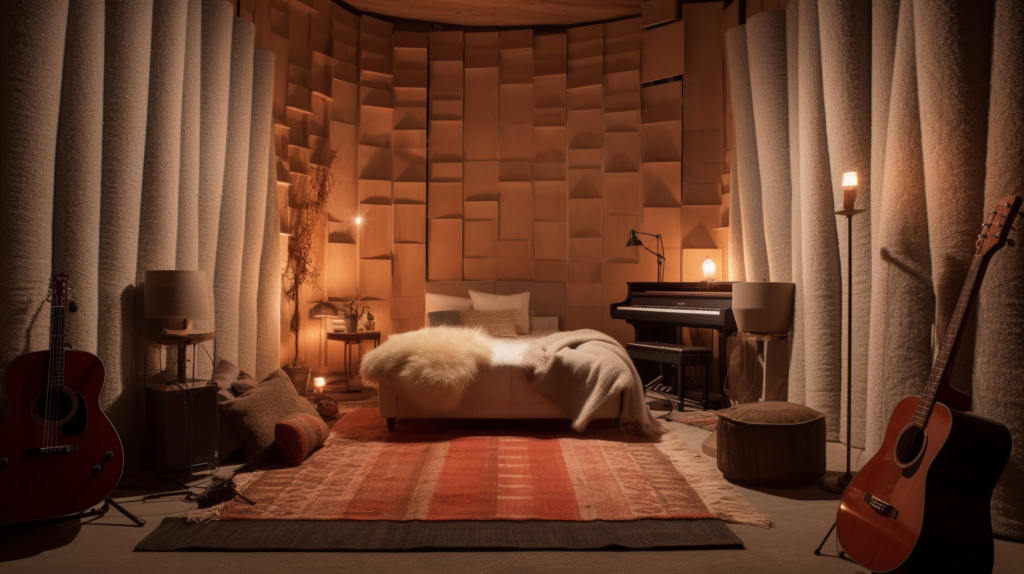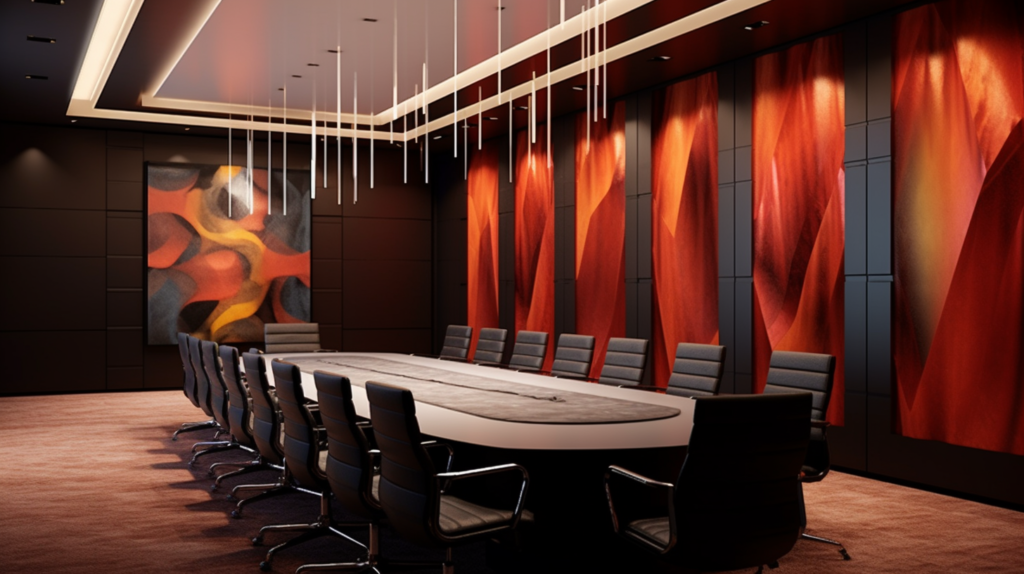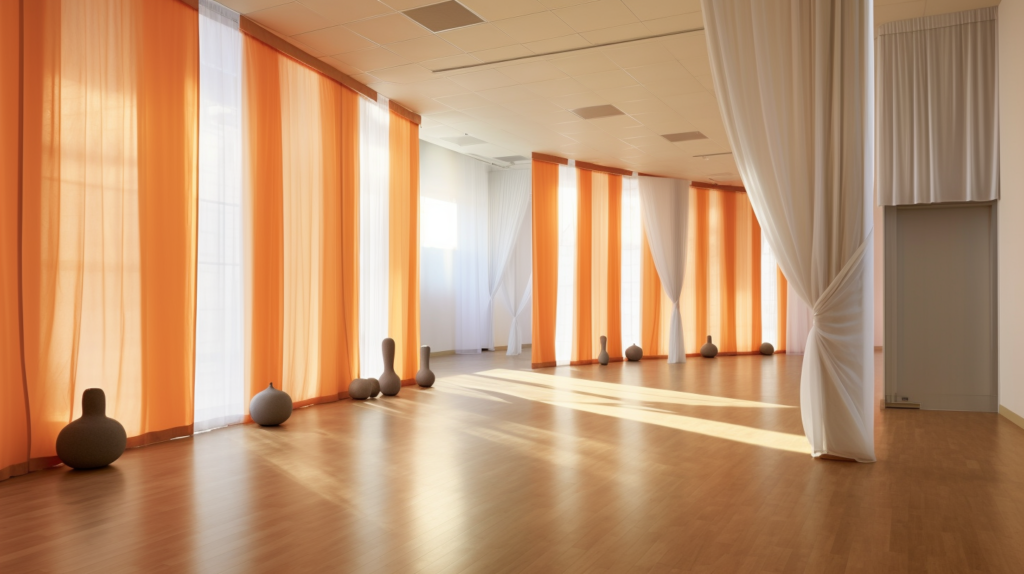Searching for silence in a noisy world often leads to one question: Do soundproof blankets really work? While they promise an oasis of calm, the reality is more complex.
Soundproof blankets are not an all-encompassing solution but a strategic tool against specific sound issues like echoes.
To understand their true effectiveness, one must navigate the intricate landscape of sound control.
Let’s dive in and unravel the truth behind soundproof blankets, comparing them with other sound management strategies, to determine their place in your acoustic arsenal.
What Are Soundproof Blankets and How Do They Work in Reducing Echoes and Reverberations?

Within the diverse spectrum of sound management solutions, soundproof blankets offer a unique blend of convenience and functionality.
These blankets, often composed of thick, absorptive materials, have become a staple in environments where echo control is crucial yet where permanent architectural changes are not an option.
They stand out for their ability to dampen noise by mitigating the reflection of sound waves off hard surfaces, which can create reverberation, echo, and ultimately, an acoustically unbalanced space.
Soundproof blankets function by providing a soft, porous surface that interrupts and absorbs sound waves.
As sound travels, it encounters various surfaces that can either reflect, absorb, or transmit the energy.
Hard surfaces, like concrete walls and glass windows, tend to reflect sound, while softer materials, like those found in soundproof blankets, absorb it.
This absorption process is critical in environments like makeshift music studios, temporary event venues, or living spaces in noisy urban areas, where controlling reverberation is necessary to maintain sound clarity and comfort.
By installing these blankets, one can significantly reduce the sharpness of sound reflections, often described as ‘slap-back’ echoes that are particularly disruptive in recordings or communications.
For instance, in a home recording setup, placing soundproof blankets around the room can help create a more controlled acoustic environment, allowing for clearer sound capture.
In industrial settings, these blankets serve the dual purpose of reducing noise levels for comfort and meeting safety standards, thereby protecting workers’ hearing and reducing the strain of operating in a noisy environment.
However, it’s crucial to understand the mechanism of these blankets to set realistic expectations.
Soundproof blankets primarily reduce mid to high-frequency sounds, which are common in everyday noise pollution.
The lower frequency sounds, such as the rumble of traffic or the hum of machinery, require more substantial materials and design strategies to effectively control.
Thus, while soundproof blankets are a versatile tool in the acoustic treatment toolkit, they are not a one-stop solution for all sound issues.
Do Soundproof Blankets Work?

The effectiveness of soundproof blankets is often discussed among those looking to improve their acoustic environment.
To answer succinctly: yes, they do work, but within the scope of their design.
These blankets are not meant to soundproof or create a space devoid of sound — but rather to reduce sound reflections that muddy the clarity of sound in a room.
For vocal performers, podcasters, or professionals conducting virtual meetings, soundproof blankets can be an invaluable asset.
By strategically placing these blankets around the recording or communication area, one can significantly diminish the echo that often plagues recordings and calls.
This can enhance the listener’s experience by providing a clearer, more direct sound without the interference of background noise bouncing off walls and hard surfaces.
In addition to their acoustic benefits, soundproof blankets are prized for their ease of use.
They can be quickly installed with minimal tools and adjusted as needed to suit the acoustic requirements of the moment.
This flexibility is particularly useful in multi-use spaces where the acoustic needs may change based on the activity — be it a yoga studio that doubles as a dance practice space or a community hall that hosts both lectures and musical performances.
Yet, it’s important to reiterate that these blankets are not the equivalent of building a soundproof room.
Soundproofing, in the strictest sense, involves not only managing echoes within a space but also preventing sound from entering or leaving that space.
This level of sound control typically requires construction-grade solutions, including specialized walls, windows, and doors that go far beyond the capabilities of a soundproof blanket.
Soundproof Blankets vs. Acoustic Panels for Acoustic Treatment

The choice between soundproof blankets and acoustic panels is a common crossroads for individuals looking to enhance the acoustic properties of their environment.
While both serve to manage sound reflections and reverberations, their applications and efficacy vary, catering to different acoustic demands and scenarios.
Acoustic panels, often constructed from specialized sound-absorptive materials like rock wool, high-density fiberglass, or standalone polyester acoustic panels, are designed to target a broader frequency range, making them more effective in professional and highly controlled acoustic environments.
Acoustic panels are engineered to reduce noise reflections across a spectrum of frequencies, from the low-end bass typical in music studios to the high-frequency chatter prevalent in busy office environments.
Their precise design allows for targeted absorption, with thicker panels generally being more effective at absorbing lower frequencies.
Panels can also be strategically placed at reflection points in a room to maximize their sound-absorbing capabilities, a practice known as room tuning, which is particularly valuable in settings where audio clarity is paramount, such as in broadcast studios or home theaters.
The versatility of acoustic panels extends beyond their acoustic benefits; they are also available in various forms that can complement the aesthetic of a given space.
From fabric-wrapped panels that can feature custom artwork to polyester acoustic panels designs that add a touch of elegance, there is a wide array of options that can enhance the visual appeal while providing functional sound control.
This dual purpose makes acoustic panels a popular choice for venues where appearance is as important as sound quality, such as corporate boardrooms, high-end restaurants, or recording studios that pride themselves on their interior design as much as their sound.
In contrast, soundproof blankets are a more accessible and flexible option for sound absorption. They offer a practical solution for transient or semi-permanent spaces, and their portability makes them ideal for situations where temporary acoustic treatment is needed.
While they may not have the same precise frequency targeting as acoustic panels, they excel in scenarios that require quick setup and takedown, such as on-location film and television sets or during live music performances in multi-purpose venues.
Their robust construction makes them durable and capable of withstanding the rigors of transport and frequent handling, which is often not the case with more delicate acoustic panels.
However, the ease of installation and versatility of soundproof blankets come with trade-offs.
Their aesthetic presence is often more industrial, and while functional, they do not offer the same level of customization and integration into a space’s design as acoustic panels.
Furthermore, their sound absorption is generally less efficient than that of acoustic panels, particularly for lower frequencies and overtones that are crucial in music and speech intelligibility.
Soundproof Blankets vs. Acoustic Foam for Acoustic Treatment

Acoustic foam and soundproof blankets are distinct in both their form and function, and understanding their differences is key to choosing the right acoustic treatment for any given space.
Acoustic foam, with its open-celled structure, is particularly adept at modifying the acoustics within a room by attenuating mid to high-frequency sound waves.
This is essential in environments like recording studios and home theaters, where the precision of sound is paramount.
The foam’s structure is designed to minimize flutter echoes and standing waves, which, if left unchecked, can significantly distort sound quality and clarity.
However, while acoustic foam can improve the acoustical properties of a space by reducing reflections, it is not particularly effective at soundproofing.
Its porous nature is excellent for breaking up sound waves but does not have the mass required to prevent sound from traveling through walls or ceilings.
In this respect, acoustic foam serves more to refine the sound within a space rather than isolate it from outside noise.
Soundproof blankets, contrastingly, offer a denser and thicker solution that can have a more noticeable impact on the acoustic dynamics of a room.
Comprised of weightier materials, these blankets are designed to absorb a significant amount of sound, which can reduce the overall noise level in a space.
They are especially beneficial in larger areas or in situations where a more substantial temporary solution is needed to manage sound, such as during live music performances or in bustling workshop environments.
While soundproof blankets are much more effective at dampening sound than acoustic foam, it’s important to clarify that they do not provide complete soundproofing.
The term ‘soundproof’ suggests a total blockage of sound, but in reality, these blankets merely reduce the transmission of sound to a degree.
They can help create a quieter and more controlled acoustic environment, but they will not entirely prevent sound from entering or exiting a space.
Their advantage lies in their ease of deployment and adaptability, as they can be conveniently draped or hung in strategic locations, making them a versatile tool in the sound manager’s toolkit.
Soundproof Blankets vs. Soundproofing Foam for Soundproofing

Distinguishing between soundproofing foam and soundproof blankets is critical for understanding their respective roles in sound mitigation.
Soundproofing foam is often much denser and thicker than typical acoustic foam, designed to impede the transmission of sound through walls, ceilings, and floors.
Its mass-loaded nature allows it to dampen vibrations and reduce the passage of sound waves, thus contributing to a quieter environment.
This type of foam is particularly useful in locations adjacent to noisy areas, such as apartments near busy streets or recording studios that require an isolation booth for vocal tracks.
The performance of soundproofing foam is greatly influenced by the density and thickness of the material.
Thicker and denser foams provide better sound isolation but at the cost of space and flexibility.
In addition, to achieve significant soundproofing results, the foam must be part of a comprehensive soundproofing strategy that includes sealing air gaps, using resilient channel systems to decouple walls.
Sometimes incorporating additional mass in the form of drywall layers or specialized soundproofing compounds.
In contrast, soundproof blankets, despite their name, are not primarily designed for soundproofing.
They are more akin to acoustic band-aids — quick fixes that can help dampen sound in a pinch but are not replacements for more substantial soundproofing measures.
Their fabric and filler materials are adept at absorbing sound, reducing reverberation, and slightly muffling noises, but they lack the mass required to effectively block sound transmission.
This makes them less suitable for applications where the goal is to prevent sound from leaking in or out of a room.
Soundproof Blankets vs. Soundproofing Panels for Soundproofing

When comparing soundproof blankets to soundproofing panels, one is comparing a light shield to a fortress wall.
Soundproofing panels are robust, often made from materials that can significantly block sound transmission, such as nitrile butadiene rubber of soundproofing material.
These materials are chosen for their ability to add mass to a structure, which is a key component in preventing sound from passing through.
The composition and installation of soundproofing panels are critical to their performance.
Panels are often part of a layered wall construction that includes an air gap and insulation, enhancing their sound-blocking capabilities.
They are installed with careful attention to detail, ensuring that there are no weak points for sound to penetrate.
Soundproofing panels are installed onto walls in a flushed manner, covering the entire wall and thus able to reduce most airborne noises and to an extend of structure-borne noises
In comparison, soundproof blankets are more of a surface-level solution. They are designed for ease of use and flexibility, rather than for integration into the fabric of a building.
While they can offer a degree of sound absorption and are useful in reducing echoes, they cannot compete with the sound-blocking efficiency of soundproofing panels.
In practice, soundproofing panels are the go-to for spaces that require stringent noise control measures, such as recording studios, home cinemas, and locations with high ambient noise levels like nightclubs or industrial facilities.
They are part of a long-term solution to noise control and are chosen for their durability and effectiveness.
Soundproof blankets, on the other hand, are selected for their convenience and are often used by musicians, podcasters, and in commercial settings where a permanent solution is not feasible or necessary.
Conclusion
In summary, selecting the right sound management solution requires understanding the unique properties of soundproof blankets, acoustic foam, and soundproofing panels.
Soundproof blankets are a versatile option for reducing echoes and are especially useful for temporary or changing spaces.
Acoustic foam is great for refining sound within a room but doesn’t significantly block noise from entering or leaving.
For a more definitive sound barrier, soundproofing panels are the preferred choice in environments where consistent noise control is crucial.
Choosing the appropriate material depends on the specific acoustic needs of your space.
Soundproof blankets can effectively enhance the sound quality in a variety of settings, provided their limitations are acknowledged.
An informed approach that combines different treatments can achieve a balanced acoustic environment that meets both practical and aesthetic requirements.
